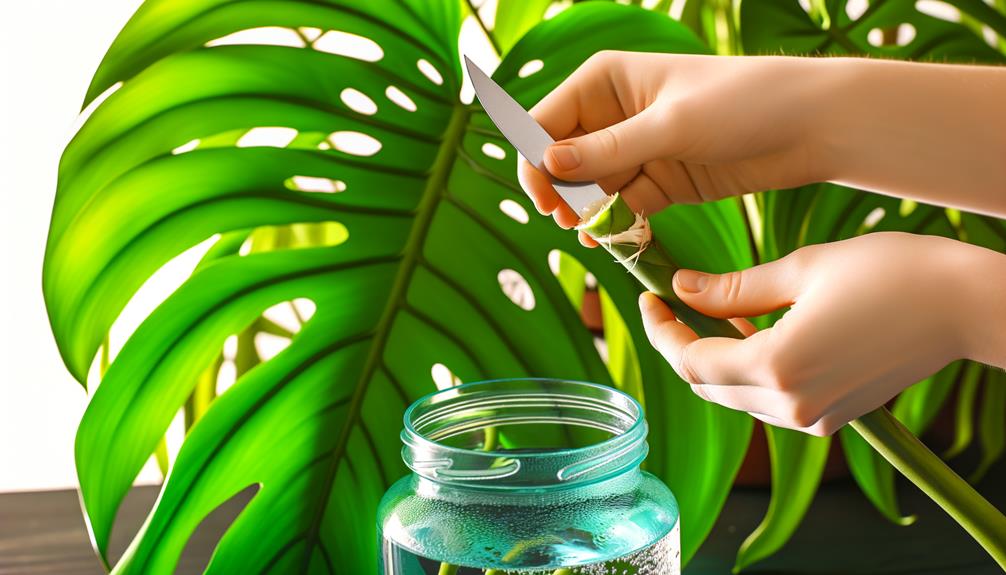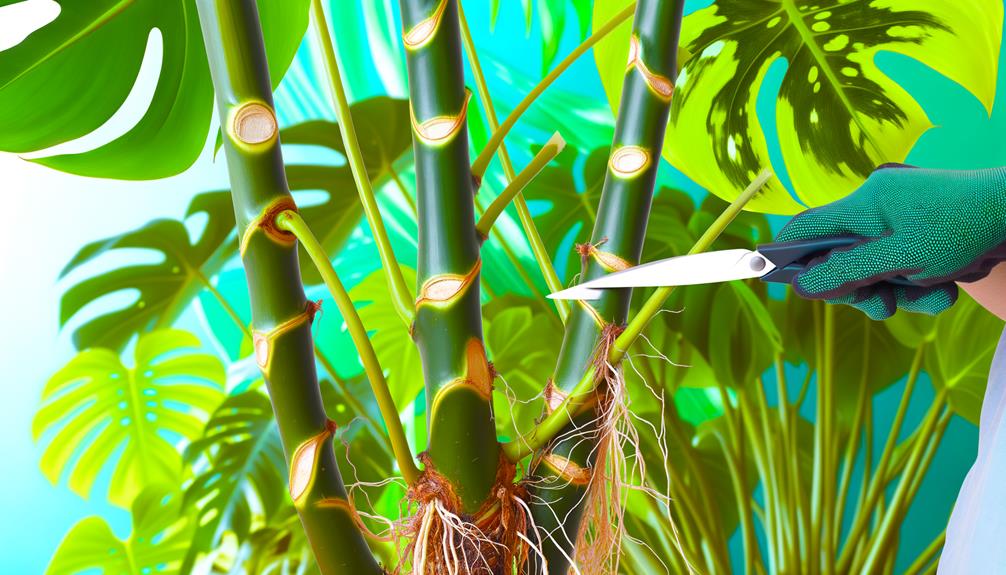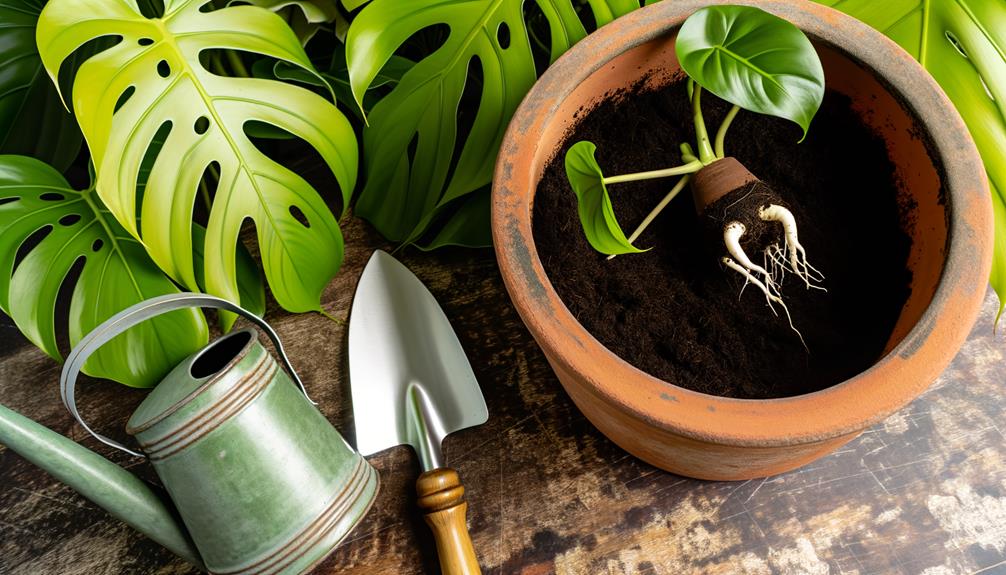How to Propagate Monstera Albo
To propagate Monstera Albo, choose a healthy stem with at least one node and firm aerial roots. Sterilize your pruning shears to prevent disease.
Make a precise 45-degree cut and confirm the node has a leaf and aerial root. For water rooting, submerge the node in clean water and change it regularly.
For soil rooting, plant the cutting in well-draining mix and keep the soil moist. Monitor for root and leaf growth, maintaining consistent humidity and temperature.
Transfer to a pot once roots are 2-3 inches. Explore further to master the intricacies of the process.

Key Takeaways
- Select a healthy stem with at least one node and aerial roots.
- Sterilize cutting tools before making any incisions.
- Cut at a 45-degree angle, ensuring the node and aerial root are included.
- Submerge the cutting in clean water or plant it in well-draining soil.
- Monitor for new root and leaf growth, and transplant to a pot when roots reach 2-3 inches.
Choosing the Right Cutting

To select the right cutting for propagating Monstera Albo, first identify a healthy stem with at least one node and a few aerial roots. The node is essential because it's where new roots will form; without it, the cutting won't thrive.
Look for stems that are robust, free from pests, and exhibit no signs of disease. Confirm the aerial roots are firm and not desiccated, as they'll support initial growth. Avoid overly mature stems; younger, vigorous ones are more likely to root successfully.
Inspect the leaves on the chosen stem—they should be vibrant, with no yellowing or browning. By choosing a cutting with these characteristics, you maximize the chances of successful propagation and healthy plant development.
Preparing Your Tools
Before you start propagating, sterilize your cutting tools to prevent disease transmission.
Gather all necessary supplies, including a clean pair of pruning shears, rooting hormone, and a suitable potting medium.
Choose healthy Monstera Albo plants for best propagation success.
Sterilizing Cutting Tools
Securing your cutting tools are sterilized is crucial for preventing the spread of pathogens and promoting healthy plant growth. Start by cleaning your tools with soap and water to eliminate any debris.
Next, immerse the blades in a disinfecting solution—70% isopropyl alcohol or a 10% bleach solution works well. Let them soak for about 5 minutes.
After soaking, remove the tools and rinse them with clean water to eliminate any residual disinfectant, which can harm the plant tissue.
Dry the tools thoroughly using a clean, lint-free cloth to prevent rust and secure they're ready for use.
Gathering Necessary Supplies
Gathering the right supplies is vital for a successful propagation of your Monstera Albo. First, make sure you have a pair of sharp, sterilized pruning shears to make clean cuts.
You'll need a clean container filled with distilled water to place the cuttings in, promoting root development. Have rooting hormone powder on hand to dip the cut ends, enhancing root growth.
Use a transparent plastic bag to cover the cuttings, maintaining high humidity levels. A spray bottle filled with water is important for misting and keeping the environment moist.
Lastly, prepare a well-draining potting mix containing perlite and sphagnum moss for transplanting rooted cuttings. These tools and materials will maximize your propagation success and support healthy plant growth.
Selecting Healthy Plants
To successfully propagate Monstera Albo, choose mother plants that exhibit robust health, vibrant foliage, and no signs of disease or pest infestation. Guarantee the plant has well-developed aerial roots and a healthy root system. Evaluating the overall vitality of the plant guarantees successful propagation.
Here's a quick reference to help you assess plant health:
| Criteria | Indicators of Health | Signs of Issues |
|---|---|---|
| Foliage | Bright, variegated, firm | Yellowing, wilting |
| Stem | Sturdy, green | Soft, brown, black spots |
| Roots | White, firm | Brown, mushy |
| Pests | No visible pests or damage | Holes, sticky residue |
Using this table, closely inspect your Monstera Albo to guarantee you're starting with the best possible specimen for propagation.
Making the Cut

When making the cut, make sure you select healthy nodes, as they contain the necessary meristematic tissue for new growth.
Use sharp, clean tools to prevent infection and facilitate a smooth incision.
Position your cut at a 45-degree angle to maximize the surface area for rooting and nutrient absorption.
Choosing Healthy Nodes
Choosing a healthy node is essential for successful Monstera Albo propagation. It guarantees the cutting has the necessary growth potential. Identify nodes that are robust and well-formed, typically marked by a small bump or a slight swelling on the stem.
Make sure the node has at least one leaf and an aerial root, which enhances rooting success. Avoid nodes that appear shriveled, discolored, or damaged, as these are less likely to develop into a healthy plant.
Examine the surrounding stem tissue; it should be firm and free from signs of disease or pest infestation. By selecting vigorous, intact nodes, you maximize the chances of a thriving new Monstera Albo plant.
Sharp, Clean Tools
Guaranteeing your cutting tools are sharp and sterile is crucial for successful Monstera Albo propagation. Clean cuts promote faster healing and reduce the risk of infections.
First, choose a pair of high-quality pruning shears or a sharp knife. Before making any cuts, sterilize the tools with a solution of one part bleach to nine parts water, or use 70% isopropyl alcohol. This sterilization step is essential to eliminate any pathogens that could harm your plant.
Make sure the blade is honed to a fine edge; dull tools can crush plant tissues, impeding healing. By maintaining sharp, sterile tools, you facilitate a clean incision that minimizes cellular damage, allowing the Monstera Albo to allocate resources effectively toward root and leaf development.
Ideal Cutting Angle
With your sterilized, sharp tools ready, make a precise incision at a 45-degree angle just below a node, as this maximizes the surface area for water absorption and root development. The 45-degree angle is pivotal because it enhances the cutting's ability to absorb nutrients and water, promoting faster root growth.
Positioning the incision just below a node guarantees that the new roots emerge from this active growth point. Make sure your incision is clean and smooth to prevent any harm to the plant tissue, which can lead to infections.
Rooting in Water
Rooting a Monstera Albo cutting in water involves submerging the stem in a clean container filled with filtered water to encourage root development.
Begin by ensuring the cutting has at least one node, as this is where roots will emerge. Use a transparent container to monitor root growth and change the water every few days to prevent bacterial buildup.
Position the cutting so the node is fully submerged, but avoid immersing the leaves to prevent rot. Place the container in indirect sunlight, maintaining a temperature around 70-75°F (21-24°C).
Within a few weeks, you'll observe root formation. Once roots are about 2-3 inches long, the cutting is ready for the next stage of propagation.
Rooting in Soil

To root a Monstera Albo cutting in soil, start by selecting a well-draining potting mix rich in organic matter to guarantee optimal root development. Choose a mix containing components like perlite, peat moss, and orchid bark. This secures adequate aeration and moisture retention.
Plant the cutting with at least one node and aerial root buried beneath the soil surface. Firmly press the soil around the cutting to eliminate air pockets that might hinder root formation.
Water the soil thoroughly right after planting to reduce transplant shock. Make sure the soil remains consistently moist but not waterlogged. You can achieve this by checking the soil moisture regularly and watering when the top inch feels dry. This promotes robust root growth and overall plant health.
Providing Ideal Conditions
Maintaining your Monstera Albo cutting's success requires keeping specific environmental conditions, such as consistent humidity levels between 60-80% and temperatures ranging from 65-80°F. Proper light is essential; indirect, bright light mimics its natural habitat. Avoid direct sunlight to prevent leaf burn.
Sustain soil moisture by watering when the top inch feels dry. Avoid leaving the pot in water to prevent root rot. Increase humidity with a humidifier or a pebble tray.
Here's a quick reference:
| Condition | Ideal Range | Tips |
|---|---|---|
| Humidity | 60-80% | Use a humidifier or pebble tray |
| Temperature | 65-80°F | Avoid cold drafts |
| Light | Bright, indirect | Avoid direct sunlight |
Following these conditions ensures the best growth.
Monitoring Growth
After establishing the ideal conditions, regularly inspect your Monstera Albo cutting for signs of new root and leaf development. Look for small, white root tips emerging from the nodes; these indicate successful root initiation. Check weekly for new leaf growth, characterized by the unfurling of small, green leaves.
Confirm the cutting remains in an environment with consistent humidity and temperature. Use a magnifying glass for detailed observation, especially in the early stages. Monitor for potential issues like root rot, identifiable by blackened, mushy roots. Maintain clean water or moist soil to support healthy growth.
Document changes meticulously, noting dates and observations to track progress. This data helps you adjust care protocols based on growth patterns and environmental responses.
Transplanting to a Pot
When the roots reach approximately 2-3 inches in length, carefully transfer the Monstera Albo cutting to a pot filled with a well-draining, aerated soil mix. Make sure the soil comprises a blend of perlite, orchid bark, and peat moss to promote peak root health. Place the cutting in the center of the pot, and gently pack the soil around the roots, making sure they're covered but not compressed. Water the soil lightly to settle it, but avoid overwatering, which can lead to root rot.
| Component | Proportion | Function |
|---|---|---|
| Perlite | 30% | Enhances drainage and aeration |
| Orchid Bark | 40% | Provides structure and aeration |
| Peat Moss | 30% | Retains moisture |
Monitor the cutting for new growth, indicating successful transplantation.
Conclusion
By selecting the right cutting, preparing your tools meticulously, and making precise cuts, you set the stage for successful propagation.
Rooting in water or soil, providing ideal conditions, and closely monitoring growth guarantee healthy development.
Finally, transplanting to a pot completes the process, transforming your Monstera Albo cutting into a thriving plant.
Through methodical steps and careful attention, you've mastered propagation, fostering both botanical beauty and your own green thumb expertise.






